


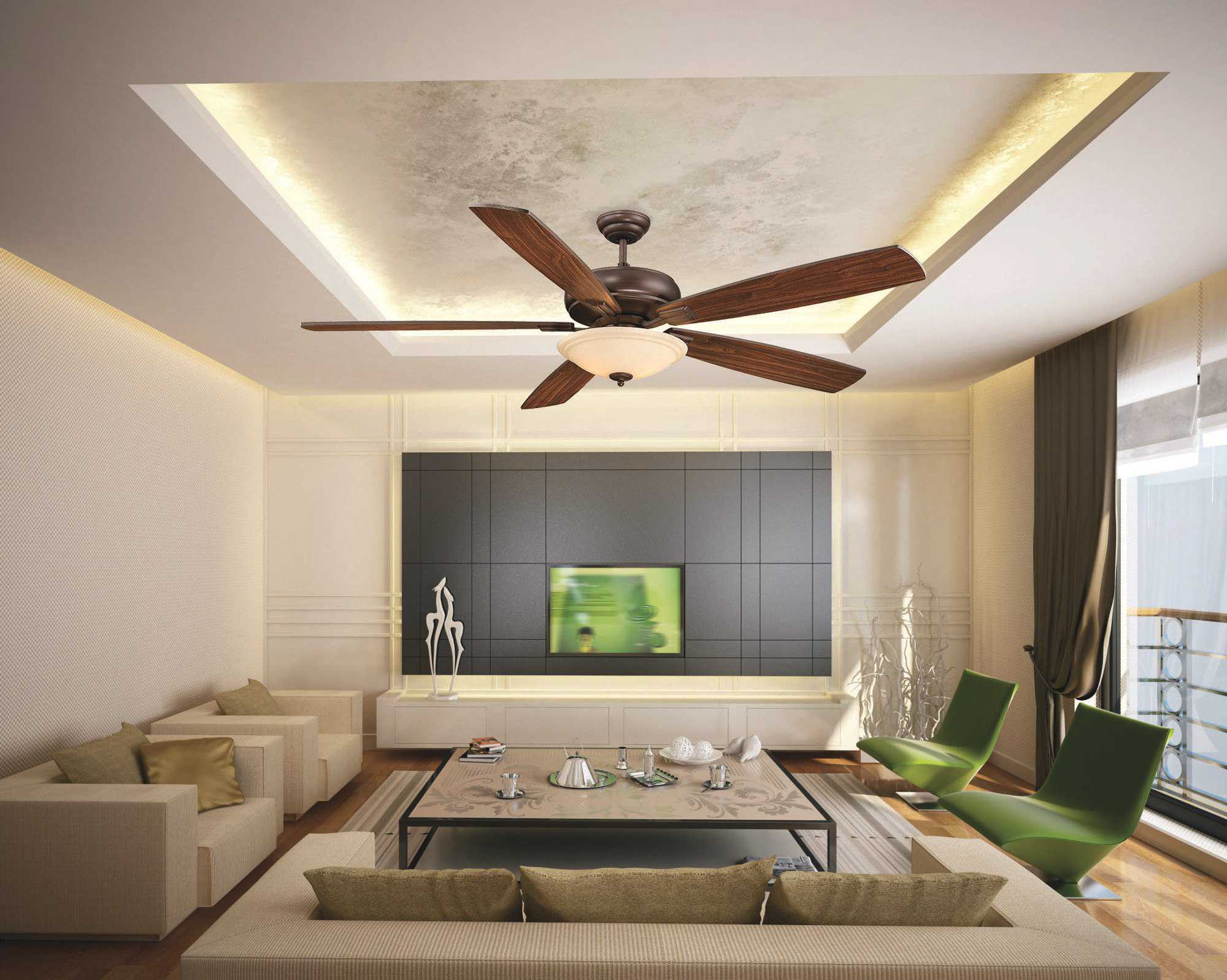
There are many benefits in incorporating a ceiling fan into your home. Ceiling fans effectively circulate air to create healthy airflow which is both energy-efficient and budget- friendly. With a variety of styles ranging from rustic to modern to traditional, a ceiling fan can be a stylish accent or a bold statement piece, adding ambiance to any room.
Ceiling fans are manufactured in an array of styles and finishes, with special functions that adjust speed and reverse airflow to complement each environment. Ceiling fans will typically consist of the fan blades, motor, light, and controls.
There are two kinds of motors that will determine how powerful and energy efficient your ceiling fan will be:
Some ceiling fans are equipped with lights, or can be used in conjunction with a lighting kit to provide overhead light and optimal air circulation. There are three common styles of lighting used with ceiling fans:
There are many different options available for ceiling fan controls: pull-cord controls, wall-mounted controls, digital controls, and wireless remote controls.
From mini fans to expansive ceiling spans, ceiling fans come in a wide range of blade spans to suit any space. Choosing the appropriate size ceiling fan will not only complement your space, but will optimize the efficiency of your fan.
The size of the ceiling fan refers to the size of the blade span. Blade span is the diameter created by the fan blades while rotating. Typically, to measure the blade span of a fan with an odd number of fan blades, measure the distance from the center of the fan to the length of one blade, and multiply by two. To measure the blade span of a fan with an even number of fan blades, measure the entire distance between opposing fan blades. The size of the room will determine the size of the fan you select. It is crucial to measure the square footage of the space you are installing your fan in to ensure that it will fit the size of your space. The following chart shows the appropriate fan size for each size room:
Blade Span
Room Size
Room Suggestions
29-36 inches
Up to 75 sq. feet
Bathrooms, kitchenettes, utility rooms
36-44 inches
76-144 sq. feet
Bedrooms, dining rooms
44-52 inches
144-225 sq. feet
Bedrooms, living rooms, kitchens
52-60 inches
25-400 sq. feet
Bedrooms, dining rooms
More than 60 inches
Over 400 sq. feet
Great rooms, outdoor spaces
No matter which mounting option you select to install your ceiling fan, it takes great care to safely and properly mount a fan onto a ceiling. Before you install any ceiling fixture, be sure an outlet box is available in the ceiling before your installation. Most ceiling fans require a metal outlet box, so make sure the outlet box is constructed from metal and not plastic before beginning installation. Remember to turn off any live power from your junction box. Once it is turned off, you can begin the steps to install a ceiling fan, which loosely follow these steps:
Note: LuxeDecor always recommends consulting a professional electrician to ensure that your ceiling fan is properly installed.
Different ceiling heights require different mounting sizes. Many ceiling fans are adaptable to multiple mounting options. Measure the height of your ceiling to determine the ideal mounting option for your space. Whether or not you’re using a downrod, always leave a minimum of 7 feet between the fan and the floor. Always allow at least a minimum of 8-10 inches between the fan blades and the ceiling.
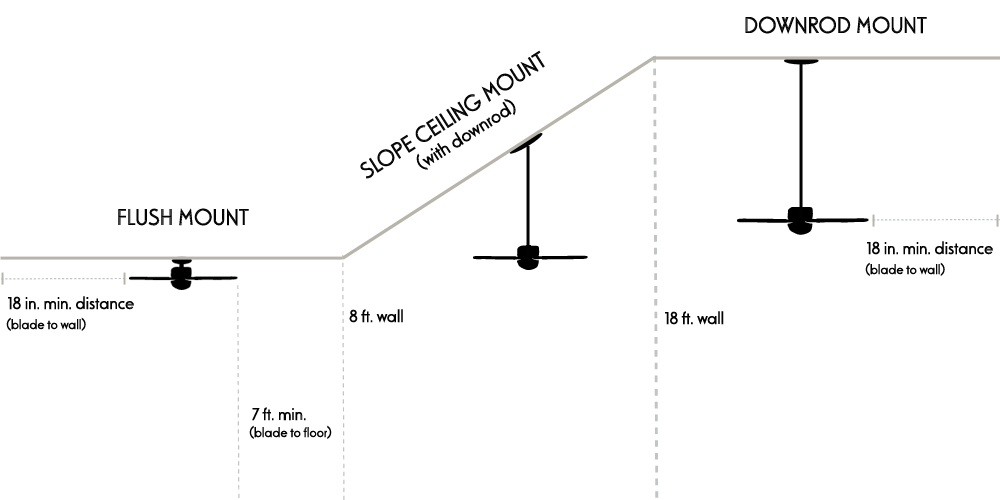
Flush Mount: Flush mounts ceiling fans are mounted flush to the ceiling, with no extra attachment. Flush mounts are ideal for rooms with low ceilings where a low profile is required.
Slope Ceiling Mount: Ceiling fans are typically meant to be installed on a flat ceiling. For sloped ceilings, such as attics, special sloped mounting adapters can be used to conjunction with your ceiling in order to properly hang a fan on ceilings with a pitch.
Downrod Mount: A downrod mount is recommended for rooms with vaulted or high ceilings that measure 8 feet or higher. Downrods help to lower a fan closer to the ground for optimal air circulation. The standard downrod length is 3 to 5 inches. Extra-tall ceilings may require a longer downrod, so make sure to check if a downrod included is the correct size needed, according to the specifications of your space. It is recommended that you allow your ceiling fan to hang 7-9 feet above the ground. The graph below shows the recommended length of a downrod for the height of your ceiling:
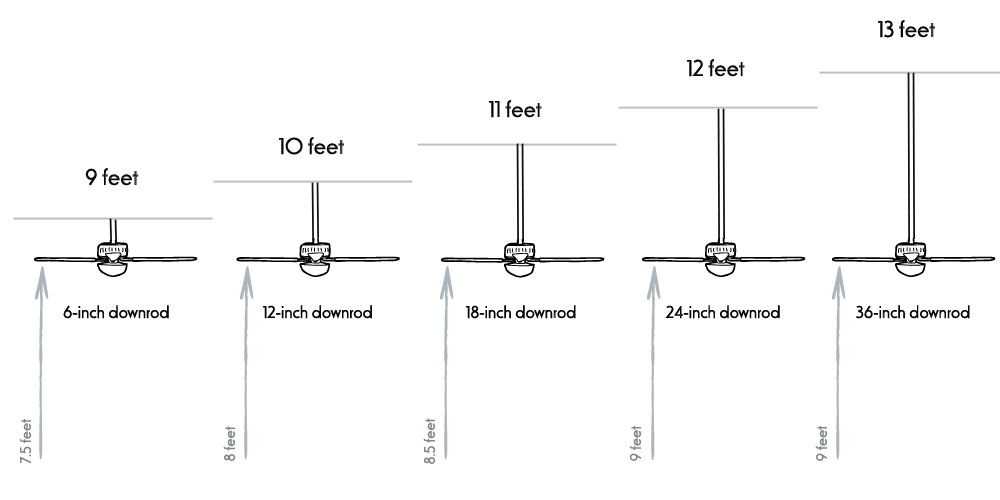
Note: If you are installing a light kit in conjunction with a ceiling fan, reduce the length of the downrod by a foot.
Since a ceiling fan’s primary purpose is to circulate air in a room, the direction at which the blades spin will affect the airflow and temperature of a room. The adjustment of the direction of the blade rotation can drastically affect the comfort in a room, and can save money on AC or heating.
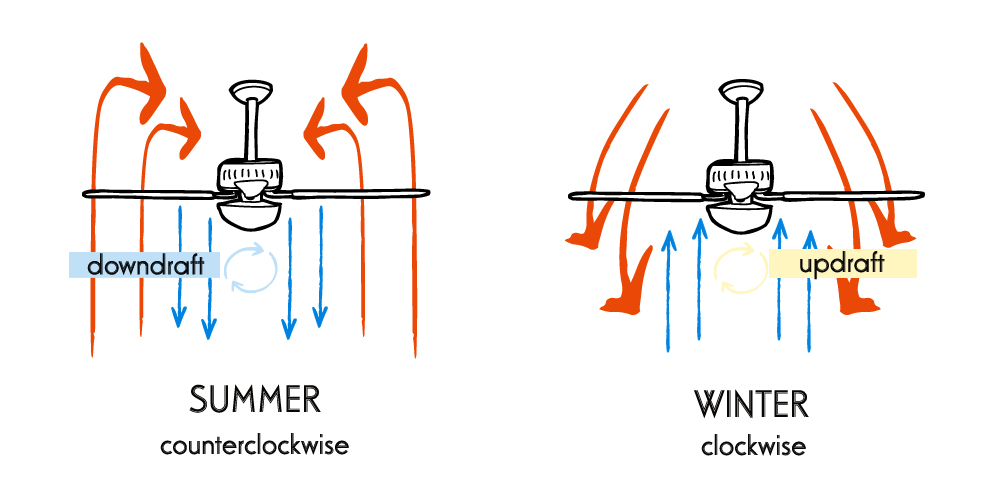
An “Energy Star Qualified” ceiling fan has passed rigorous testing by the EPA that proves that it is highly efficient. Energy Star ceiling fans must come with a minimum 30-year motor warranty, a 2-year lighting kit warranty, and a 1-year components warranty. Investing in a ceiling fan with an Energy Star label allows you to minimize environmental waste, and offers better performance that will reduce overall utility costs. Energy Star Qualified fans are typically 20% more efficient than fans that have not been “Energy Star Qualified”.
Most fixtures (ceiling lights, wall lights, outdoor lighting, and ceiling fans) sold in the United States have been tested and rated by Underwriters Laboratories (UL), an independent product safety certification organization. The UL listing indicates which environment a fixture is best suited for: dry, damp, or wet. Each location in your house is exposed to different environments which can affect the performance of your ceiling fan, so it is important to check the UL listing on a ceiling fan before purchasing. These ratings help you choose the right fan for an indoor space, a covered porch, or a semi-covered outdoor patio.
Any fan may be installed indoors. However, outdoor fans are specially manufactured for outdoor conditions. Outdoor fans are constructed and designed with materials that can withstand temperature changes, humidity, and exposure to moisture. Look for the “UL Damp” or “UL Wet” listings to ensure that your ceiling fan has been certified for outdoor use. Outdoor ceiling fans should be at least 52 inches
Ceiling fan accessories allow you to modify your fan to better enhance ventilation according to personal preference and space.

Most indoor ceiling fans feature a hanging propeller frame, which consists of fan blades (that resemble a plane’s propeller) connected to a rod, which is attached to the ceiling. Hanging propeller fans are stationary and are intended to ventilate an entire room.
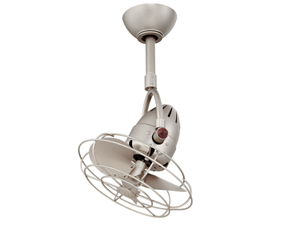
Directional fans can be turned at an angle to provide oriented ventilation to a specific area. Unlike hanging propeller ceiling fan models which ventilate an entire room from one location, directional fans can be used to ventilate distinct areas of a room. Oscillating fans are considered directional fans.
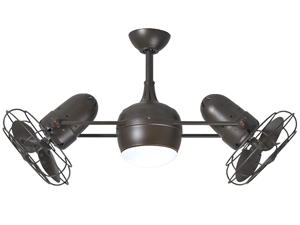
A combination of a hanging propeller fan and a directional fan, rotational fans typically consist of multiple sets of blades that spin independently of each other. The sets of independent fans are connected to a hanging rod which rotates the sets of blades independently.



